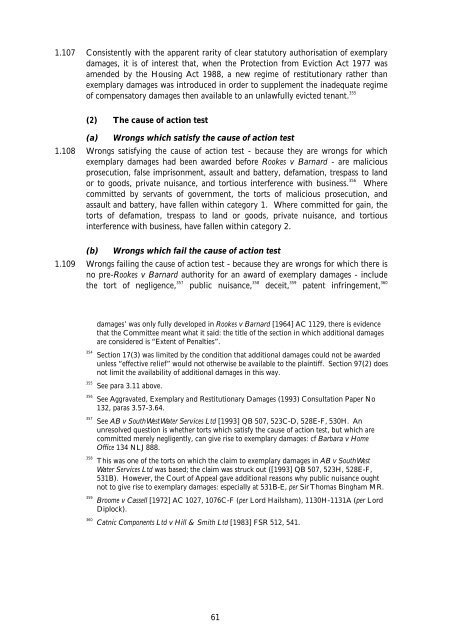Aggravated, Exemplary and Restitutionary ... - Law Commission
Aggravated, Exemplary and Restitutionary ... - Law Commission
Aggravated, Exemplary and Restitutionary ... - Law Commission
Create successful ePaper yourself
Turn your PDF publications into a flip-book with our unique Google optimized e-Paper software.
1.107 Consistently with the apparent rarity of clear statutory authorisation of exemplary<br />
damages, it is of interest that, when the Protection from Eviction Act 1977 was<br />
amended by the Housing Act 1988, a new regime of restitutionary rather than<br />
exemplary damages was introduced in order to supplement the inadequate regime<br />
of compensatory damages then available to an unlawfully evicted tenant. 355<br />
(2) The cause of action test<br />
(a) Wrongs which satisfy the cause of action test<br />
1.108 Wrongs satisfying the cause of action test - because they are wrongs for which<br />
exemplary damages had been awarded before Rookes v Barnard - are malicious<br />
prosecution, false imprisonment, assault <strong>and</strong> battery, defamation, trespass to l<strong>and</strong><br />
or to goods, private nuisance, <strong>and</strong> tortious interference with business. 356<br />
Where<br />
committed by servants of government, the torts of malicious prosecution, <strong>and</strong><br />
assault <strong>and</strong> battery, have fallen within category 1. Where committed for gain, the<br />
torts of defamation, trespass to l<strong>and</strong> or goods, private nuisance, <strong>and</strong> tortious<br />
interference with business, have fallen within category 2.<br />
(b) Wrongs which fail the cause of action test<br />
1.109 Wrongs failing the cause of action test - because they are wrongs for which there is<br />
no pre-Rookes v Barnard authority for an award of exemplary damages - include<br />
the tort of negligence, 357<br />
public nuisance, 358<br />
deceit, 359<br />
patent infringement, 360<br />
damages’ was only fully developed in Rookes v Barnard [1964] AC 1129, there is evidence<br />
that the Committee meant what it said: the title of the section in which additional damages<br />
are considered is “Extent of Penalties”.<br />
354 Section 17(3) was limited by the condition that additional damages could not be awarded<br />
unless “effective relief” would not otherwise be available to the plaintiff. Section 97(2) does<br />
not limit the availability of additional damages in this way.<br />
355 See para 3.11 above.<br />
356 See <strong>Aggravated</strong>, <strong>Exemplary</strong> <strong>and</strong> <strong>Restitutionary</strong> Damages (1993) Consultation Paper No<br />
132, paras 3.57-3.64.<br />
357 See AB v South West Water Services Ltd [1993] QB 507, 523C-D, 528E-F, 530H. An<br />
unresolved question is whether torts which satisfy the cause of action test, but which are<br />
committed merely negligently, can give rise to exemplary damages: cf Barbara v Home<br />
Office 134 NLJ 888.<br />
358 This was one of the torts on which the claim to exemplary damages in AB v South West<br />
Water Services Ltd was based; the claim was struck out ([1993] QB 507, 523H, 528E-F,<br />
531B). However, the Court of Appeal gave additional reasons why public nuisance ought<br />
not to give rise to exemplary damages: especially at 531B-E, per Sir Thomas Bingham MR.<br />
359 Broome v Cassell [1972] AC 1027, 1076C-F (per Lord Hailsham), 1130H-1131A (per Lord<br />
Diplock).<br />
360 Catnic Components Ltd v Hill & Smith Ltd [1983] FSR 512, 541.<br />
61
















